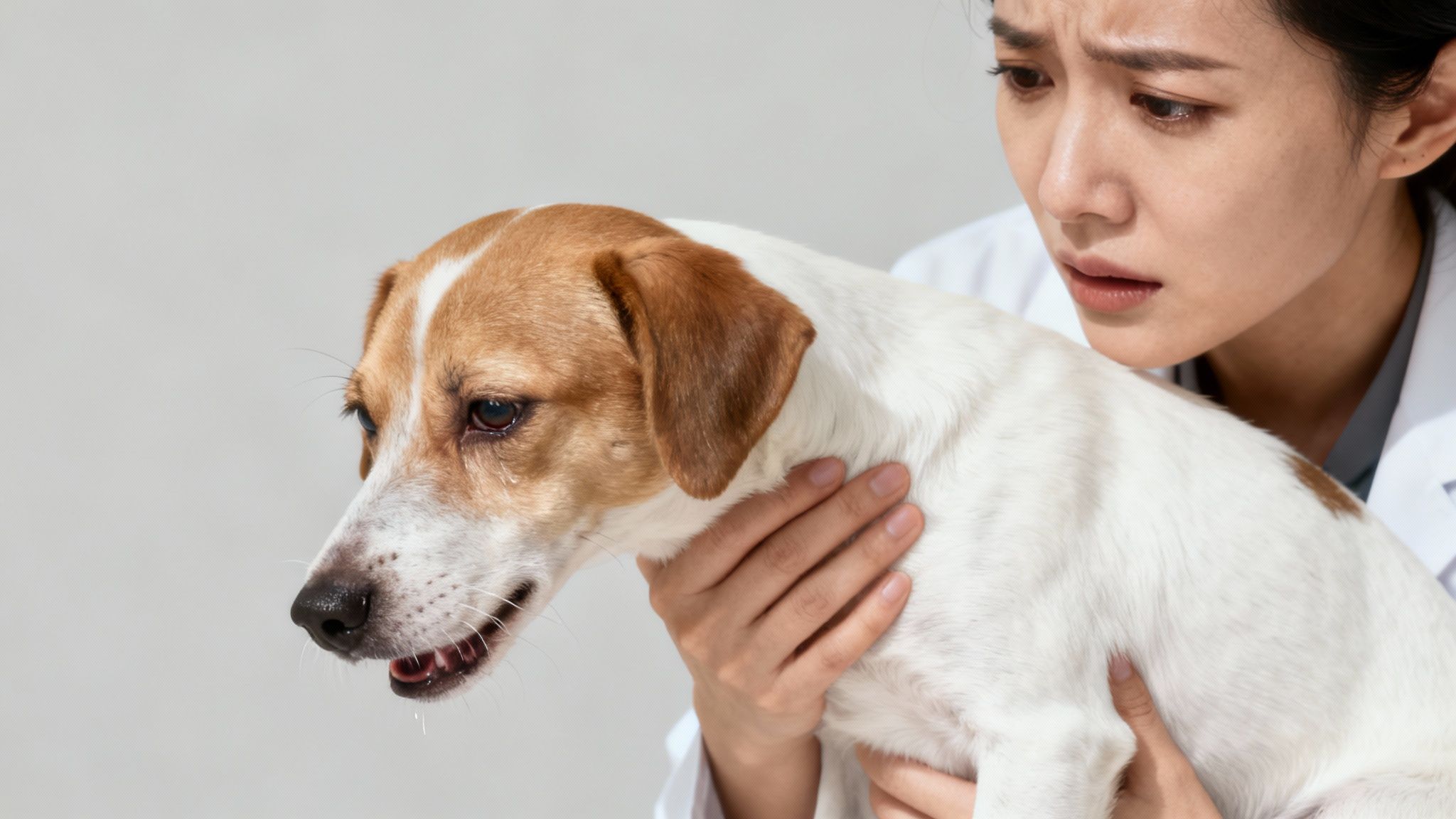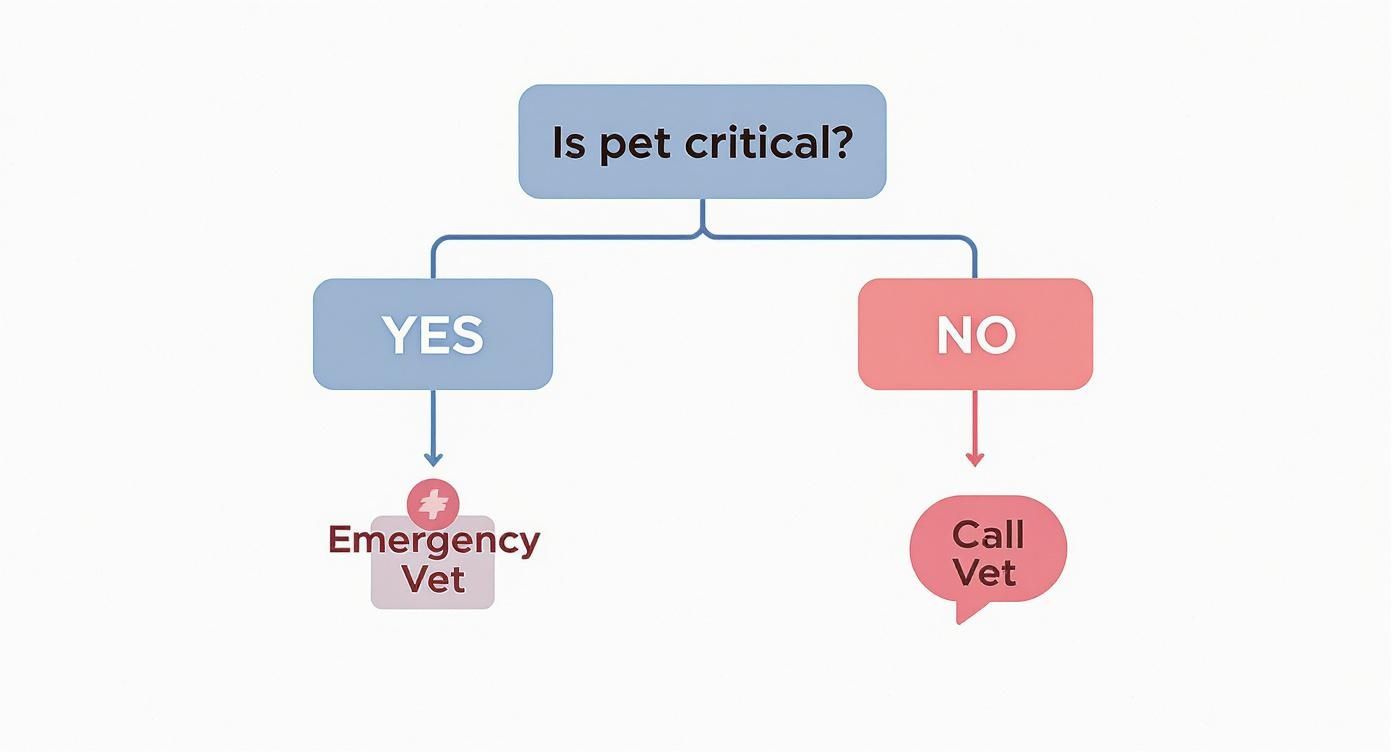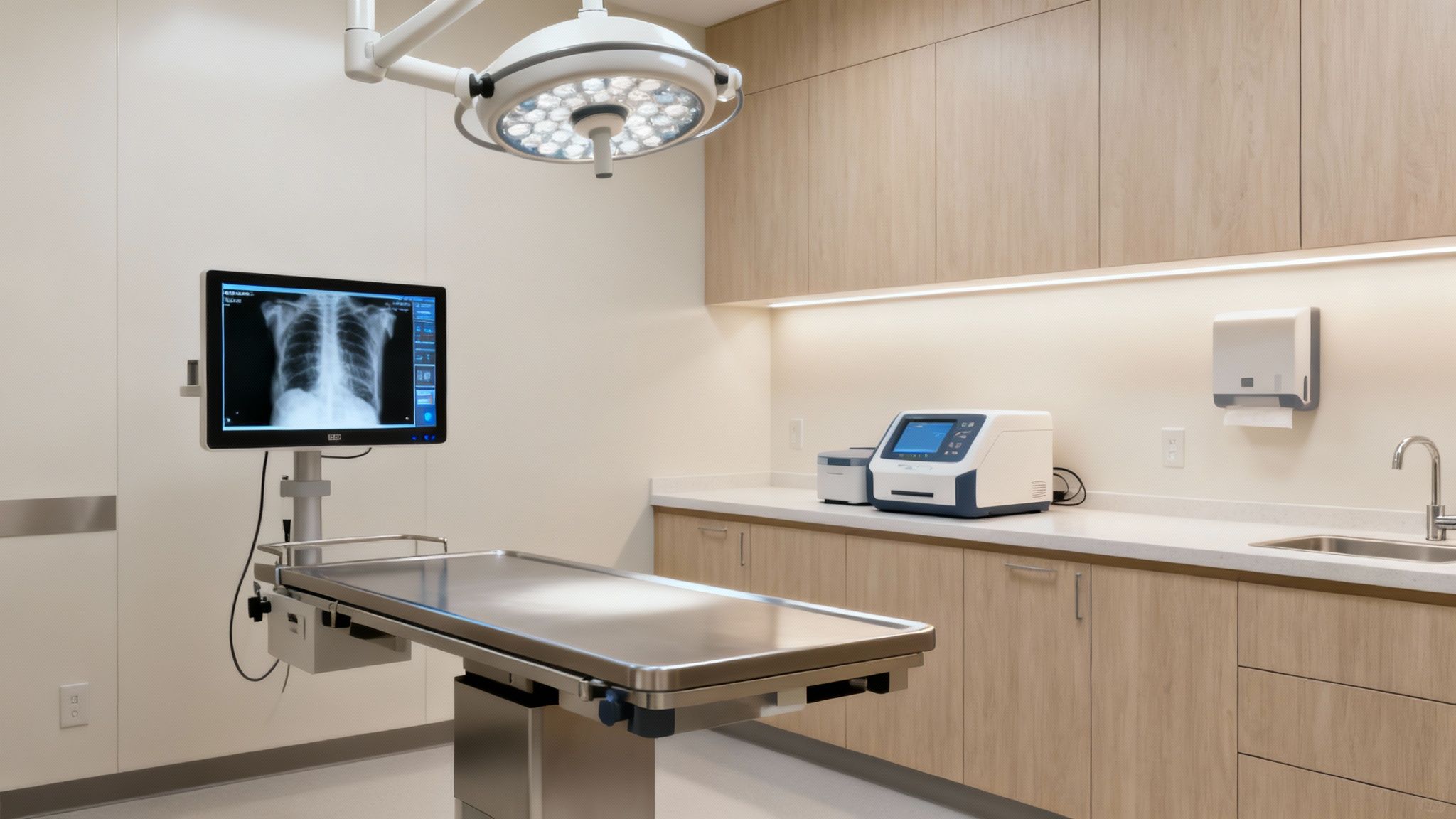Our pets live in the moment, completely unaware of what time the clock shows. That’s why having a 24-hour veterinary service on call brings incredible peace of mind for those middle-of-the-night emergencies or sudden weekend illnesses. It means that no matter when a crisis hits, expert medical help is ready and waiting.
That sinking feeling when you realize something is truly wrong with your pet is unforgettable. One minute everything is fine, and the next you're thrown into a panic, questioning every little symptom. Is it a real emergency, or can this wait until the vet clinic opens in the morning?
Learning to spot the critical warning signs is one of the most important things you can do as a pet owner. It helps you cut through the fear and take decisive, focused action when every second counts.

Think of your pet's health like a finely balanced system. When something goes wrong, it sends out alarm bells. Your job is to learn which alarms signal a true, time-sensitive crisis that needs the immediate attention of a 24-hour veterinary team.
Some symptoms are so serious they should never be ignored. These aren't just subtle hints; they are loud and clear calls for help that demand an immediate trip to an emergency vet.
Not every emergency is as dramatic as a collapse. Some signs can be more subtle but just as dangerous if left untreated. For example, constant vomiting or diarrhea can quickly lead to life-threatening dehydration, especially in smaller or younger pets.
Another serious sign is a swollen, hard-feeling abdomen, which could indicate "bloat" (Gastric Dilatation-Volvulus). This is a devastating condition that can turn fatal in just a matter of hours.
Recognizing an emergency is all about trusting your gut. You know your pet better than anyone else. If their behavior feels fundamentally "wrong" or they seem to be in significant pain, it's always safer to get a professional opinion than to wait and hope for the best.
Being prepared also means knowing the risks specific to our environment. Here in the UAE, understanding the dangers of our desert climate and learning about preventing pet heatstroke can stop an emergency before it even starts.
When in doubt, the choice is clear: calling a 24-hour veterinary clinic is always the right move for the pet you love.
Walking into a 24 hour veterinary hospital with your sick or injured pet is one of the most stressful things a pet owner can go through. Your mind is racing, your heart is pounding, and the unfamiliar, often chaotic environment can feel totally overwhelming. Knowing what happens from the moment you walk in can help quiet some of that anxiety, letting you focus on what's most important: your pet.
The first thing to understand is a concept called triage. It’s the same system human emergency rooms use. The veterinary team doesn't see patients on a first-come, first-served basis; they prioritize them based on how critical their condition is. A cat struggling to breathe will always be seen before a dog with a minor cut because their life is in immediate danger.
This system is in place to make sure the most critical patients get life-saving care without a second to spare. I know waiting is incredibly difficult when you're worried, but trust that the team is working as fast as they can to help every single animal.
Once it’s your pet's turn, a vet nurse or technician will bring them back for an immediate assessment of their vital signs. They'll check their heart rate, breathing, temperature, and gum color. Think of it as a rapid snapshot to gauge how stable your pet is.
From there, the veterinarian will perform a more complete examination. Based on what they find, they’ll almost certainly recommend diagnostic tests to get a clear picture of what's going on inside your pet's body. These usually include:
These tools are absolutely essential for a fast, accurate diagnosis, which is the foundation of any effective emergency treatment. You can learn more about the advanced care we provide in our guide to pet emergency services.
After the first round of diagnostics, the veterinarian will sit down with you to discuss what they've found. They'll explain your pet’s condition in plain terms, outline the recommended treatment options, and give you a detailed estimate of the costs involved. This is your time to ask every question you have to make informed decisions for your pet. For a deeper dive into navigating these tough situations, this guide to dog emergency surgery is a very helpful resource.
The demand for this level of specialized care is growing rapidly here in the UAE. As more people experience the joy of pet ownership, the need for advanced 24 hour veterinary facilities has surged. It’s part of a larger trend—the region's veterinary market is on track to exceed USD 8 billion by 2028, which shows just how deeply we're integrating the health of our animals with our own.
The emergency team has three main goals: stabilize your pet, relieve their pain, and create a clear path toward recovery. Clear, open communication is a huge part of this, making sure you are a partner in your pet’s care every step of the way.
It might feel like chaos, but remember that every action the veterinary team takes is deliberate. It’s all aimed at one thing: getting the best possible outcome for the companion you love.
To help you visualize the process, here’s a quick summary of what a typical emergency visit looks like from start to finish.
StageWhat HappensKey PurposeTriageA quick assessment by a vet nurse to determine the urgency of your pet's condition.To prioritize the most critically ill or injured patients for immediate care.Initial ExamThe veterinarian performs a thorough physical examination and discusses your pet's history.To get a baseline understanding of your pet's health and identify key problems.DiagnosticsThe vet may recommend tests like blood work, X-rays, or an ultrasound.To get a precise diagnosis and see what’s happening internally.Treatment PlanThe vet explains the findings, proposes a treatment plan, and provides a cost estimate.To ensure you are fully informed and can make decisions about your pet's care.StabilizationYour pet receives initial treatment, such as IV fluids, pain medication, or oxygen.To manage pain, treat shock, and get your pet's condition under control.Hospitalization or DischargeDepending on their condition, your pet is either admitted for ongoing care or discharged with a home care plan.To provide continuous monitoring for critical patients or set up a clear path for recovery at home.
This structured approach ensures that even in the midst of an emergency, your pet receives methodical, high-quality care designed to give them the best chance at a full recovery.
When your pet is in trouble, those first few moments can feel like an eternity. What you do right then, before you even get to a 24 hour veterinary clinic, can make a world of difference. Acting quickly and correctly can stabilize your pet, prevent the injury from getting worse, and genuinely improve their chances of a full recovery. Think of these first aid steps as the crucial bridge to getting them the professional help they need.
Your main goal is simple: prevent any more harm and get to the vet as fast as you safely can. It's also important to remember that a pet in pain might lash out or act unpredictably, so always keep your own safety in mind.
This straightforward decision tree shows the choice you'll face in an emergency: should you start first aid on the way, or is it better to call us for guidance first?

The bottom line is clear: for anything serious, immediate action paired with professional veterinary care is the only way forward.
If you think your pet has swallowed something poisonous—whether it's chocolate, a household plant, or human medication—your first thought might be to make them vomit. Do not do this unless a vet has specifically told you to. Some toxins can cause even more harm on the way back up.
Instead, here’s what you should do immediately:
For a deep cut that's bleeding heavily, your job is to apply firm, direct pressure. Use a clean towel, t-shirt, or sterile gauze and press it firmly against the wound. Hold it there as you make your way to the clinic. If the blood soaks through, don't take the first cloth off. Just add another layer on top and keep applying pressure. It's a simple step, but it can absolutely be a lifesaver.
If your pet is choking, you might see them pawing frantically at their mouth, coughing hard, or gasping for air. If you can clearly see the object and can easily pull it out with tweezers without pushing it deeper, do so. But if you can't, or if your pet passes out, you need to get to an emergency clinic without a second's delay.
Your role in a pet emergency is that of a first responder. Your actions—staying calm, stabilising your pet, and providing crucial information to the veterinary team—are an essential part of the life-saving process.
Heatstroke is a severe, life-threatening emergency, especially in the UAE’s climate. If you see signs of overheating—like frantic panting, heavy drooling, stumbling, or collapse—you have to move fast.
Get them into a cool, air-conditioned space immediately. You can start to cool them down by draping cool, damp towels over their body, focusing on their head, neck, and groin area. Never use ice or ice-cold water, as this can send them into shock. The goal is to bring their temperature down gradually while you head straight to the nearest 24 hour veterinary hospital for the critical care they need.
When your pet is in crisis, the last thing you should be worried about is figuring out where to go. Knowing exactly where to find a reliable 24 hour veterinary hospital—and having their number saved in your phone—can shave precious minutes off your response time when every single second counts.
Our dedicated teams in both Dubai and Abu Dhabi are always on standby, ready to provide the urgent care your companion needs, no matter the time of day or night.
This need for round-the-clock care is becoming more common across the region. In fact, the veterinary healthcare market in the Middle East and Africa is expected to jump from USD 3.82 billion in 2024 to USD 6.91 billion by 2033. This growth is fueled by a rise in pet adoption right here in the UAE and a stronger focus on animal health overall.
If you find yourself facing an emergency, we can't stress this enough: please call us while you're on your way. It’s a simple action that makes a huge difference.
A quick phone call gives our team a vital head start. We can begin preparing for your pet's specific needs, get the right equipment ready, alert our specialists, and even give you first-aid advice over the phone. It ensures we're fully prepared from the moment you walk through our doors.
Our Al Wasl branch is the central hub for 24-hour emergency and critical care in Dubai. The team here is specially trained and equipped to handle the most serious cases with the speed and expertise your pet deserves.
For pet owners in the capital, our Khalifa City A branch offers the same high standard of continuous care. It’s a fully staffed hospital, ready to respond to any after-hours emergency. You can learn more about our dedicated 24-hour veterinary care in Abu Dhabi and the services we provide there.
When your pet is in crisis, every second stretches into an eternity. In those critical moments, the tools and technology available to the veterinary team can mean the difference between a close call and a heartbreaking outcome. Choosing a 24 hour veterinary hospital is about more than just finding a place with the lights on; it’s about accessing a facility that’s ready for immediate, life-saving action.
Think of it this way: a talented chef can whip up a decent meal with just a few basic utensils, but a state-of-the-art kitchen empowers them to create a masterpiece, even under intense pressure. It's the same for our vets. An experienced veterinarian can work wonders with their hands and a stethoscope, but advanced equipment gives them the power to diagnose and treat complex emergencies with incredible speed and accuracy.

This difference is never more apparent than with diagnostics. Sending samples to an outside lab means waiting for results—a delay a critically ill pet simply can't afford. A properly equipped emergency clinic cuts out that dangerous waiting game entirely.
When a clinic has its own diagnostic tools on-site, the whole dynamic of emergency care shifts. Vets stop guessing and start seeing. They can move from a suspicion to a confirmed diagnosis in a matter of minutes, not hours.
Here are the on-site capabilities that make all the difference:
These tools are the bedrock of how modern clinics enhance patient care, providing a foundation built on speed and certainty.
In an emergency, time is tissue. The faster a veterinarian can get a precise diagnosis, the faster they can deliver targeted treatment, relieve pain, and increase the chances of a full recovery.
This dedication to advanced care isn't just a local trend; it's a global movement. Take the veterinary market in South Africa, for example, which has seen massive growth, with major cities like Cape Town and Johannesburg now home to incredibly advanced animal hospitals. This reflects a worldwide understanding that better tools simply lead to better medicine.
At the end of the day, every single piece of equipment in a 24 hour veterinary hospital has one job: to give your pet the best possible chance. Advanced technology means faster pain relief, more effective treatments, and a clearer path to getting your beloved companion back home with you, safe and sound. It helps turn a terrifying emergency into a manageable medical event, guided by expertise and precision.
When you’re rushing your pet to a 24-hour veterinary hospital, it’s completely normal for your mind to be racing with a million questions and worries. We get it. Juggling the practical side of an emergency visit with the emotional toll can be overwhelming, so getting clear answers to common questions can bring a little bit of calm to a very stressful situation.
Understanding what to expect, from costs to what happens if your pet needs to stay, helps you feel more in control. We believe in being upfront and open, making sure you have all the information you need to make the best decisions for your companion.
Yes, please do! While you should never delay heading out the door in a life-threatening situation, a quick call while you're on the way is incredibly helpful. It isn't about booking an appointment; it's about giving our emergency team a crucial head start.
When you call ahead, it allows us to:
This one simple step helps us get right to work, ensuring your pet gets critical care the very moment you arrive.
This is one of the first questions on every pet owner's mind, and for good reason. The cost of an emergency visit can vary quite a bit because it’s based entirely on what your pet needs to get better. A straightforward case that just needs an exam and minor treatment will naturally cost less than a complex one involving surgery, overnight hospitalization, and extensive tests.
Before we proceed with any major treatments, our veterinarian will sit down with you and provide a detailed estimate. This document will clearly outline the recommended tests, procedures, and medications, along with their costs. We are committed to total financial transparency and will discuss all the options with you, helping you make an informed decision that works for your pet and your budget.
Our number one goal is to provide the best possible medical care for your pet. We will always discuss costs with you upfront and work together to create a treatment plan you are comfortable with.
If your pet's condition requires constant monitoring or intensive treatment, our veterinarian might recommend hospitalization. This just means they’ll stay with us overnight, or maybe for a few days, in our dedicated patient ward where they can rest and recover.
During their stay, they'll be under the watchful eye of our veterinary team around the clock. This includes regular checks on their vital signs, administering medications, managing their pain, and providing any other treatments they need. Our on-site team is here 24/7, so if their condition changes at any point—day or night—we can respond immediately. We'll also be sure to give you regular updates on their progress so you’re always in the loop.
We know how hard it is to be separated from your best friend, especially when they aren't feeling well. We absolutely encourage visits, as it can be comforting for both you and your companion. To make sure our hospital runs smoothly and all our patients get the uninterrupted care they need, we do have specific visiting hours and policies in place.
Just have a chat with our front desk team to arrange a good time to visit. This helps us make sure your pet’s treatment schedule isn’t disrupted and that our team can give you their full attention to provide a thorough update on how things are going.
For emergencies, routine check-ups, and everything in between, the compassionate team at The City Vet Clinic is here to support you and your pet. Find out more about our comprehensive services by visiting us at https://thecityvetclinic.com.